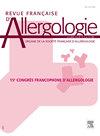Impact of remibrutinib on dermatology-related quality of life in patients with chronic spontaneous urticaria in the Phase 3 REMIX-1 and REMIX-2 studies
IF 0.3
4区 医学
引用次数: 0
Abstract
Prérequis/contexte
Remibrutinib is an oral, highly selective Bruton's tyrosine kinase inhibitor that has demonstrated superiority vs placebo (pbo) in change from baseline in Urticaria Activity Scores at week (Wk) 12, with a favourable safety profile, in the primary analysis of the REMIX-1 and 2 studies.
Objectifs
Here, we report the effect of remibrutinib on Dermatology-Related Quality of Life (DLQI) in REMIX-1 and 2 up to Wk 52. Our objective was to evaluate whether long-term treatment with remibrutinib sustains improvements in QOL.
Méthodes
REMIX-1/-2 are identical phase 3 studies, in adults CSU patients inadequately controlled by H1-AH. Patients were randomised 2: 1 to receive oral remibrutinib 25 mg or pbo twice daily (bid) over a 24-Wk double-blind treatment period. This was followed by a 28-Wk open-label treatment period, in which all patients, including those previously receiving pbo, were assigned to remibrutinib 25 mg bid. The number of patients that achieved DLQI = 0–1 (no impact on patient's life) and the DLQI change from baseline were recorded up to Wk 52.
Résultats/discussions
At baseline, patients in both trials reported on average a high disease impact of CSU on QOL, based on DLQI scores (mean ± SD: 14.2 ± 7.0 vs 13.5 ± 6.8 in REMIX-1 and 14.0 ± 7.5 vs 13.6 ± 6.7 in REMIX-2). Significantly more patients treated with remibrutinib vs pbo achieved no impact of disease on QOL, i.e. DLQI = 0–1 (imputed data) at Wk 12 (REMIX-1: 39.0 vs 22.2%, P < 0.001; REMIX-2: 35.7 vs 18.3%, P < 0.001) and at Wk 24 (REMIX-1: 46.1 vs 28.1%, P < 0.001; REMIX-2: 40.7 vs 20.3%, P < 0.001). DLQI was greater at Wks 4, 12 and 24 with remibrutinib vs pbo. At Wk 52, there was an improvement in DLQI change from baseline (mean ± SD; observed data) for all patients (REMIX-1: −9.9 ± 7.3 with remibrutinib and −9.3 ± 7.7 with remibrutinib post pbo; REMIX-2: −9.6 ± 8.4 with remibrutinib and −8.5 ± 8.0 with remibrutinib post pbo).
Conclusion
Remibrutinib demonstrated significant improvements in DLQI vs pbo. For patients in the remibrutinib arm, the improvement in DLQI was sustained up to Wk 52. For patients who received pbo and transitioned to receive remibrutinib at Wk 24, a comparable improvement in DLQI was achieved at Wk 52.
REMIX-1和REMIX-2 iii期研究中瑞米鲁替尼对慢性自发性荨麻疹患者皮肤相关生活质量的影响
emibrutinib是一种口服,高选择性布鲁顿酪氨酸激酶抑制剂,在REMIX-1和2研究的初步分析中,在第12周(Wk)的荨麻疹活动评分与基线的变化中,已证明优于安慰剂(pbo),具有良好的安全性。在此,我们报告remibrutinib对REMIX-1和remix - 2至52周的皮肤相关生活质量(DLQI)的影响。我们的目的是评估长期使用瑞米鲁替尼是否能维持生活质量的改善。m thodesremix -1/ 2是相同的3期研究,在成人CSU患者中没有充分控制H1-AH。患者被随机分为2:1组,接受口服remibrutinib 25mg或pbo,每天两次(bid),为期24周的双盲治疗。随后是28周的开放标签治疗期,在此期间,所有患者,包括先前接受pbo的患者,被分配到remibrutinib 25mg bid。记录DLQI = 0-1(对患者生命无影响)的患者数量和DLQI自基线的变化,直至第52周。基于DLQI评分,两项试验中的患者在基线时平均报告了CSU对生活质量的高疾病影响(REMIX-1的平均±SD: 14.2±7.0 vs 13.5±6.8,REMIX-2的平均±SD: 14.0±7.5 vs 13.6±6.7)。与pbo相比,瑞米替尼治疗的患者在第12周没有疾病对生活质量的影响,即DLQI = 0-1(输入数据)(REMIX-1: 39.0 vs 22.2%, P <;0.001;REMIX-2: 35.7% vs 18.3%, P <;0.001)和第24周(REMIX-1: 46.1 vs 28.1%, P <;0.001;REMIX-2: 40.7 vs 20.3%, P <;0.001)。与pbo相比,remibrutinib在第4、12和24周时DLQI更高。在第52周,DLQI变化较基线有所改善(mean±SD;所有患者(REMIX-1:瑞米鲁替尼组为- 9.9±7.3,瑞米鲁替尼组为- 9.3±7.7;REMIX-2:瑞米鲁替尼组为- 9.6±8.4,瑞米鲁替尼组为- 8.5±8.0)。结论瑞米鲁替尼可显著改善DLQI与pbo。对于瑞米鲁替尼组的患者,DLQI的改善持续到第52周。对于在第24周接受pbo并过渡到接受remibrutinib的患者,在第52周时实现了DLQI的可比改善。
本文章由计算机程序翻译,如有差异,请以英文原文为准。
求助全文
约1分钟内获得全文
求助全文
来源期刊

Revue Francaise d Allergologie
Medicine-Immunology and Allergy
自引率
33.30%
发文量
349
期刊介绍:
La Revue Française d''Allergologie : un véritable forum pour faire connaître des travaux originaux et permettre la diffusion de l''information auprès de toutes les spécialités concernées par les pathologies allergiques. La Revue Française d''Allergologie (8 numéros par an) est au carrefour de nombreuses spécialités - dermatologie, pédiatrie, ORL, pneumologie, ophtalmologie, médecine interne - qui, toutes, ont à traiter des maladies allergiques. Les symptômes des allergies fondés sur des mécanismes communs sont le plus souvent associés et se succèdent chez un même patient. En forte progression depuis 20 ans, les maladies allergiques sont dans l''attente de perfectionnements et d''avancées thérapeutiques qui permettront aux nombreux patients qui en sont atteints de mieux vivre avec leurs allergies. La Revue Française d''Allergologie se veut donc un véritable forum de discussions et d''échanges entre tous les spécialistes confrontés aux pathologies
 求助内容:
求助内容: 应助结果提醒方式:
应助结果提醒方式:


